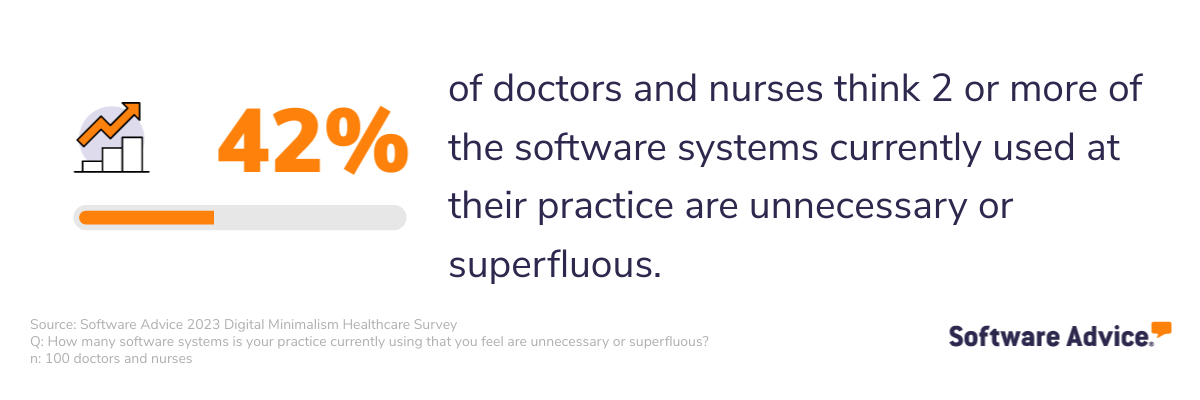Superfluous Software and Annoying Alerts Are Contributing to Healthcare Burnout
Are you the type of person who leaves their phone on silent at all times, or do you let it ring out?
If you're the former, you may already understand alert fatigue. In a healthcare context, this phenomenon describes situations where healthcare workers receive so many notifications and alerts on various apps and programs throughout their day that they become desensitized to them—which can lead to ignoring important alerts regarding patient safety.
You may wonder how big of a problem this actually is. In our recent survey, we learned that 82% of doctors and nurses report receiving up to 30 urgent notifications that require immediate action on their part every single day.*
What's more, high notification volume and inefficient tech stacks create more work for employees, making them more likely to work overtime and burnout faster.

Finding ways to combat alert fatigue and reduce burnout among healthcare employees should be a priority for everyone from independent practices to large hospital organizations. Fortunately, practice owners and leaders can rely on their own employees to help them determine which systems are superfluous, and which ones can be consolidated to streamline alerts.
Key findings:
26% of doctors and nurses receive more than 50 work-related messages or notifications in a day, but 67% say only 1-10 of these notifications are actually important.
A third of doctors and nurses have had to learn 5 or more new software systems since starting at their current practice.
65% of doctors and nurses say they often feel overwhelmed by the number of times they have to interact with different software systems in their daily routines.
72% of doctors and nurses say at least one of the software systems being used at their practice is unnecessary or superfluous.
Practices are adopting too many new apps that aren’t actually helpful
The more apps you have, the more notifications your employees receive. So the question is, are all of the apps you pay for actually valuable?
Nearly a third of survey respondents say their practice adopts a new software system to manage their practice at least once a year, and of those 14% say this happens multiple times per year. Consider the amount of time, energy, and attention employees have to devote to learning an entirely new software system.
That's even higher in the healthcare industry, as many systems require higher attention to security to protect patient data and maintain HIPAA compliance.

Add all of this up and it's not hard to see how notification fatigue can easily set in.
While 59% of doctors and nurses say they receive between one and 30 work-related notifications each day, 26% receive more than 50 alerts every single day. However, 67% say they only consider between one and 10 to be actually urgent or require immediate action on their part. Another 10% say none of the notifications they see are important.

This means that most healthcare workers are receiving at least 20 notifications per day that don’t require their attention. With rates like that playing out over time, you can see how doctors or nurses might miss an important alert in all the other noise.
The fix: Avoid using one system for one problem, focus on all-in-one tools
A lot of the problem comes from the fact that doctors and nurses have to split their attention between multiple software systems or apps all day long. Our survey shows that 20% of doctors and nurses have at least five different accounts or logins for various software systems used at their practice.
Between taking accurate notes, testing and diagnosing, coding procedures for billing, responding to messages, and let's not forget actually treating the patients in front of them, your staff has a lot on their plate.
To help them focus, you want to consolidate as many different systems as you can. One of the best ways to do this is by adopting an integrated practice management suite that will house billing, EHR, and patient portal platforms on the same system so you can cut down on the number of accounts and notifications coming from different sources.
Notification fatigue causes burnout, and pressure to work extra hours
So, we know what the main issue is, but how is it manifesting among employees? The answer is that it’s contributing to burnout. By implementing new software systems every year, putting staff through rigorous training and the stress of learning these systems, and expecting them to use so many different platforms each day, practice leaders are contributing to a culture of overworking and burnout.
Our survey found that 65% of employees often feel overwhelmed by the number of times they have to interact with different software systems in their daily routines. And 42% say they feel two or more of the software systems being used at their practices are unnecessary or superfluous.

More than a third of respondents say they waste at least five hours each week using software tools, inputting duplicate data, or addressing system notifications. That's valuable time your employees could be spending on important tasks.
Our survey also found that many doctors and nurses feel a lot of pressure to make up for these wasted hours with their own time: 68% say they log in to work systems or conduct work during their personal hours "somewhat" or "extremely often."
Similarly, 20% feel a lot of pressure from co-workers, managers, or bosses to work during their off hours.
You can see the pattern developing here. By having a clunky tech stack, practices create more work for their employees which, in turn, leads to overworking and burnout. Addressing this issue is one more way you can support your employees by making their lives easier, and that's the fastest way to establish a positive work environment and retain valuable employees for many years.
The fix: Employees are a resource—use them
The best way to do that is to listen to these employees. They are your boots on the ground when it comes to using the software tools you’ve adopted to manage your practice. If they tell you something isn’t adding value to their daily lives or to your patients, take that seriously.
You'll likely be doing yourself a favor, too, considering 40% of doctors and nurses in our survey estimate their practices are spending at least $10,000 a year on paid software applications that they don’t use regularly.
Not only will culling your tech stack help alleviate the burnout your employees are feeling, it will also keep you from wasting money on accounts that aren’t actually helping your practice run more efficiently.
Minimize burnout by integrating critical systems with help from daily users
Few things are more important to practice leaders than protecting their employees' time. Sure, most software is designed to make life easier by automating processes and streamlining systems, but you have to be careful about assessing whether or not that's actually true when adopting new software.
If you're running your practice on multiple software systems, take a moment to consider if there’s any fat you can trim. Either by moving toward a consolidated software suite that houses multiple applications used to run your practice, or simply asking your employees if there are any systems they find unnecessary.
It's also worth remembering that you are ultimately responsible for creating a culture that supports employees. The most successful practices are those that cultivate a strong policy of supporting personal time, collecting and valuing feedback from employees, and taking real action when it counts.
Survey methodology
Software Advice's 2023 Digital Minimalism survey was conducted in July of 2023 among 100 doctors, RNs, nurse practitioners, and physician assistants. We used screening questions to ensure respondents' titles fit our criteria and that everyone who participated in our survey had been working at their current practice for at least two years.
We conducted this survey in order to gain insight into what software platforms are commonly used by these healthcare workers, how much time they spend learning and using them, and to what extent software contributes to medical employee burnout.